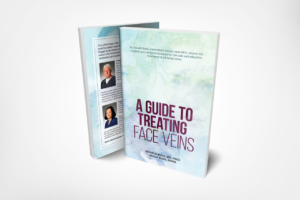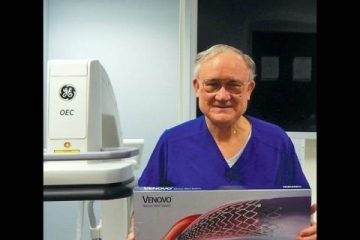BOOK REVIEWS: ‘A GUIDE TO TREATING FACE VEINS’

‘A Wonderful Resource’
By Joseph D. Raffetto, MD
“A Guide to Treating Face Veins” is a wonderful resource and compilation of work by Dr. Ronald Bush and Mrs. Peggy Bush. Facial veins are uncommonly treated in most clinical practices but is a common problem among patients who seek medical advice for unsightly facial veins and would desire treatment.
Treating facial veins is not a common practice, and many practitioners who treat patients with lower-extremity varicose veins would be averse to treating veins in the face due to lack of knowledge and experience. However, practitioners treating varicose veins may have referrals from primary care physicians or even patient’s request asking the clinician to help them with their facial veins and improve the patient’s morale, self-esteem and image, and overall happiness.
Although most treatments of facial veins are for cosmetic reasons, the importance is that the patient is self-conscious of this problem, and it is likely affecting their overall well-being and quality of life.
In this comprehensive and one of a kind work I congratulate the authors for their systematic, well researched, well written and well-illustrated review in the treatment of facial veins. The authors have done a wonderful job in their illustrations of the anatomy of veins coursing through the face, providing critical details in face vein flow and pathways, and the importance of the connections between visible facial veins and deeper veins within the face.
The review lists the importance of applying specific pressure at critical junctures to control the dispersion of foam during treatment and avoid the foam from entering deeper veins, especially the ophthalmic veins.
The sections are arranged in four anatomic areas of interest in treating the frontal, temporal, suborbital and periocular veins, and eyelid veins. Each section describes anatomic details, objectives of treatment and clear technical aspects to performing the procedure.
Other interesting sections covered are facial telangiectasia and venous lakes tumors, which are also common disorders seen in older individuals that will likely have the patients ask for treatment options.
The review ends with sections on mixing foam and potential problems and how to avoid and treat if complications do occur. There are important pearls in each of the figures and text, with key points that must be observed while treating veins of the face.
In addition, the authors provide a step-by-step approach to each of the treated veins, with information on cannulation, application of pressure in the veins to keep the foam localized, the dosing of sclerosant foam to use and procedural care following injections as well as expectations.
Discussion on using laser, ohmic thermolysis and radiofrequency energy is also presented in treating telangiectasia and venous lake tumors. The sections are succinct, easy-to-follow instructions and contain essential information for treating different levels of facial veins.
For any clinician considering treating veins of the face, anatomic knowledge and procedural steps are essential, and this illustrated treatise is an excellent resource to the proper treatment of facial veins and to maximize and achieve favorable results.
‘A Reference Source’
By Stephen F. Daugherty, MD
“A Guide to Treating Face Veins,” written by Ron and Peggy Bush, is an excellent manual for those who treat or desire to treat cosmetic concerns associated with veins of the face. The normal and abnormal venous anatomy of the face and the important venous drainage to avoid occluding with treatment are reviewed with color photographs and anatomical drawings.
The angular vein and other potential pathways for endovenous foam to reach the cavernous sinuses are discussed. The “danger triangle” where the angular, supraorbital, supratrochlear and superior palpebral veins converge is illustrated. Technical maneuvers such as compression points, direction of foam injection, and concentrations and volumes of foam injection are outlined for each of the veins of the face that might be treated with foam.
The importance of occluding the scalp vein inflow to the target veins of the face is discussed as are the techniques for occluding the scalp veins. Methods for treating the frontal veins of the forehead, the temporal veins, suborbital and supraorbital veins, and veins of the eyelids with endovenous foam are described in detail.
The treatment of facial telangiectasia with laser, intense pulsed light or ohmic thermolysis is reviewed. Venous lake tumors present as raised, bluish, smooth masses on the face or lips, which can be treated with laser or ohmic thermolysis with simple techniques described by the authors.
The descriptions of techniques include many suggestions to reduce the risk of complications from treatment of veins of the face. The authors found only one case in the medical literature of blindness after sclerotherapy of a facial vein, though there are more reports of blindness occurring after injections of fillers or adipose tissue, most commonly with injections near the orbit. The authors’ techniques to avoid foam passing into the superior ophthalmic vein and cavernous sinus are described.
Finally, the importance of recognizing blanching of the skin as a sign of potential passage of foam into the arterial system and emergent treatment for such a change are described.
The key concepts for safe treatment of veins of the face with foam are no different from treatment with foam in other venous beds, but the authors provide considerable detail specific to treating veins of the face.
This book will long be a reference source for the neophyte and experienced clinicians who treat veins of the face. VTN


